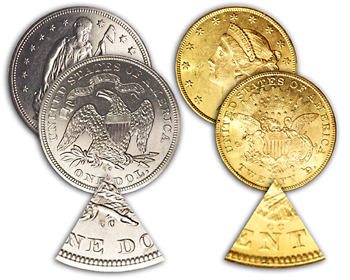|
"Making Cents"
The Signal
Saturday, January 6, 2007
| O |
The Carson City Mint came about as a result of the lobbying of silver mining interests in Nevada who saw a need for a local mint rather than shipping their silver to San Francisco or New Orleans in the 1860s. The legislation authorizing the building of a Mint in Nevada passed on March 4, 1863; construction did not commence until 1866, and no coins were minted until 1870. The intervening time was needed for finding the right equipment, personnel and other basics for coinage operations.
The first six-ton press installed at the Mint was a Morgan & Orr steam-powered press made in Philadelphia. It arrived in Carson City in 1969 and on Feb. 11, 1870, was put into operation.
The first coinage was the 1870 silver dollar — a very low-mintage coin and now a well-established rarity. The first gold coin, a $20 piece, was also struck in 1870 and is also a recognized rarity. In 1878, the press suffered a fracture in its arch and was repaired at a local foundry of the Virginia & Truckee Railroad. The Mint ceased operation after the 1885 production and did not start up again until 1889.
The silver dollars produced in 1889 are among the most sought-after Morgan dollars and can bring well into the high five figures at auction in mint state.
In addition to silver dollars and $20 gold coins, the Mint produced smaller silver coins, the rarest being the 1876-CC 20-cent piece of which only about 20 are known today. It also produced other denominations of gold coins — all of which are scarce to rare.
In 1893, the Mint closed down, and the presses — there were several in use at the time — were removed in 1899. The original press No. 1 went to Philadelphia, where it was remodeled in 1930 to operate with electric power. In 1945, it was transferred to San Francisco, where it was put to use in coinage until 1955, when the San Francisco Mint shut down its regular coinage production.
The antique press No. 1 was purchased for $225 by a private group headed by local Judge Clark J. Guild and moved back to Carson City in 1958. It was a popular attraction at the Nevada State Museum, which was located inside the former Carson City Mint.
In 1964, Nevada's Eva Adams, who was the director of the U.S. Mint, ordered the old press shipped to the Denver Mint and put back into operation, where it was producing tens of millions of coins over the next three years. In 1967, it was returned to Carson City and was used to strike Nevada bicentennial medals in gold, silver, copper and bronze, as well as other medals for the Nevada State Museum.
Press No. 1 is currently being operated and maintained by the State Museum of Nevada.
With the increase in railroad connections from coast to coast by the 1890s, the need for a Carson City Mint rapidly declined as the other branch mints — at San Francisco and New Orleans — met the needs of local and regional banks.
Silver ore mined in Nevada could easily be shipped to other mints for processing. By 1893, the Carson City Mint became obsolete and was closed.
Its total coinage output was very small in comparison to the Philadelphia Mint; thus, coins with the "cc" mintmark are now among the favorites of collectors.
The Treasury vaults in Washington, D.C., managed to accumulate a few million silver dollars from the closed mints at New Orleans (1909) and Carson City, and in 1964, the General Services Administration began to sell off these surplus dollars. Carson City dollars received special attention and were packaged in hard plastic holders marked with the designation "Carson City." They sold for prices varying from $15 to $300 for the scarcer dates.
Today, some of these dates — such as 1879-CC — sell for more than $10,000. The more common 1882-CC, 1883-CC, and 1884-CC dollars sell for about $200 in their GSA holders.
If anyone managed to find some used "cc" dollars in their visits to Las Vegas in the 1960s or 1970s, when Morgan dollars actually were used in slot machines, they are lucky indeed, as even the most common, circulated specimens are worth $40 or more.
Dr. Sol Taylor of Sherman Oaks is president of the Society of Lincoln Cent Collectors and author of The Standard Guide to the Lincoln Cent. Click here for ordering information.
©2007, THE SIGNAL · ALL RIGHTS RESERVED.

![[Most Recent Quotes from www.kitco.com]](http://www.kitconet.com/images/quotes_special.gif)

